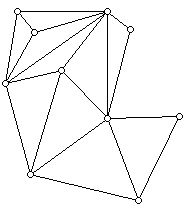
Sheet G: Polygons, Triangulated Polygons and Near-Triangulations
Prepared by:
Joseph Malkevitch
Department of Mathematics
York College (CUNY)
Jamaica, New York 11451
email:
malkevitch@york.cuny.edu
web page:
http://york.cuny.edu/~malk
1. Find the number of degrees for the interior angle of a regular convex polygon with:
a. 3 sides
b. 4 sides
c. 5 sides
d. 6 sides
e. n sides (n at least 3).
2, Can every convex n-gon be subdivided into triangles using the existing vertices for vertices of the triangles? If so, how many triangles are formed?
3. Definition: A diagonal of a (strictly) convex n-gon is a line segment which joins two vertices of the n-gon which do not form a side of the polygon.
(Strictly convex means that no three vertices of the polygon lie along a straight line.)
How many diagonals does a convex 3-gon have? How many diagonals does a convex 4-gon have? How many diagonals does a convex 5-gon have? How many diagonals does a convex n-gon have? How would you prove that your formula works in general?
4. Suppose a regular 5-gon has side length 1. Construct a pentagram with the same vertices as the regular 5-gon. What are the the side length and interior angle of the pentagram?
5. Construct as many different ways as you can to subdivide a regular 6-gon into triangles. What seems a reasonable criterion for saying that two such triangulations are the "same" (e.g. isomorphic)? Can you think of another reasonable criterion from the one you chose already? (Hint: You may want to start with a regular 4-gon to think the ideas through?)
6. Think about the issue of the angle sum of the interior vertices of a non-convex but simple polygon. Can one always triangulate (subdivide into triangular regions) such a polygon using only the existing vertices?
Comment:
The study of polygons and their triangulations is a very rich topic. There issues such as finding the triangulation which has minimal total edge weight (using Euclidean distance as the length of segments) as well problems concerning visibility (guards) and whether there are nice geometrical "moves" which will take one triangulation to another one. There are many interesting questions about "triangulated polygons" and, again, more generally, graphs embedded in the plane so that only the infinite face might not be a triangle. Such plane graphs are sometimes called near-triangulations. The figure below shows a near-triangulation whose infinite face has 8 sides.
